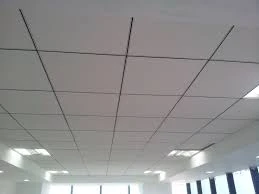10 月 . 02, 2024 17:43 Back to list
Comparison of PVC Ceiling and Gypsum for Home Decoration and Durability
PVC Ceiling vs Gypsum Ceiling A Comprehensive Comparison
When it comes to interior design and construction, the choice of ceiling materials can significantly affect the overall aesthetics, maintenance, and functionality of a space. Two popular options in this regard are PVC (Polyvinyl Chloride) ceilings and gypsum ceilings. Each material has its unique set of features, advantages, and disadvantages. This article aims to provide a comprehensive comparison between PVC and gypsum ceilings to help you make an informed decision.
Material Composition and Structure
PVC ceilings are made from a type of plastic, namely polyvinyl chloride. This material is lightweight, durable, and resistant to moisture, making it a suitable choice for areas prone to humidity, like bathrooms and kitchens. PVC panels come in various designs, colors, and finishes, allowing homeowners to customize their ceilings according to their preferences.
On the other hand, gypsum ceilings are made from a mineral-based material and typically come in the form of gypsum boards or plaster. Gypsum is renowned for its fire-resistant properties and sound insulation capabilities. While gypsum ceilings can be painted and finished in various ways, they are generally less versatile in terms of color and design compared to PVC.
Installation Process
The installation process for both PVC and gypsum ceilings varies significantly. PVC panels are relatively easy to install; they can be directly stuck or suspended from the existing ceiling framework. This process can often be completed in a short time, making PVC ceilings a preferred choice for those seeking a quick renovation.
In contrast, gypsum ceilings require more meticulous installation. The process involves measuring, cutting, and securing the gypsum boards to a framework, followed by taping, mudding, and sanding the seams. This comprehensive installation procedure can be time-consuming and may require professional expertise, particularly for intricate designs such as coffered or tray ceilings.
Durability and Maintenance
pvc ceiling vs gypsum

When it comes to durability, PVC ceilings generally outperform gypsum ceilings, particularly in terms of moisture resistance. PVC is impermeable to water, and thus, it will not warp, crack, or become damaged in humid environments. This feature makes PVC a low-maintenance option, as it only requires occasional cleaning to maintain its appearance.
Gypsum ceilings, however, are more susceptible to moisture damage. In areas with high humidity, gypsum boards can absorb water, leading to mold growth and structural deterioration. Renovating damaged gypsum ceilings often involves replacing sections or full boards, which can be costly. Regular maintenance, including painting and sealing, is also necessary to keep them looking fresh.
Cost Considerations
Cost is an important factor when choosing between PVC and gypsum ceilings. Generally, PVC ceilings tend to be more affordable due to their lower material and installation costs. The long-term savings on maintenance and replacements further enhance their cost-effectiveness.
Gypsum ceilings, while initially more expensive, may provide better sound insulation and fire-resistance benefits, justifying the higher price for some homeowners. However, over time, the cumulative costs associated with repairs and reconditioning may outweigh the initial investment.
Conclusion
Ultimately, the choice between PVC and gypsum ceilings depends on individual needs, budget, and aesthetic preferences. PVC ceilings offer durability, ease of installation, and low maintenance, making them ideal for humid environments. Gypsum ceilings, while more intricate to install and maintain, can deliver superior fire resistance and sound insulation.
Weighing the pros and cons of each material will help guide your decision-making process. Regardless of your choice, both options have the potential to enhance the beauty of your living space when executed with care and consideration.
-
Revolutionizing Interior Design with Ceilings t grid Suspended SystemNewsOct.29,2024
-
Revolutionizing Ceiling Design with ceiling access panel with Gypsum Tile WaterproofNewsOct.29,2024
-
Revolutionizing Interior Design with PVC Gypsum Ceiling: A Comprehensive GuideNewsOct.29,2024
-
Elevating Interior Design with High quality Mineral Fiber Ceiling TilesNewsOct.29,2024
-
Revolutionizing Interior Design with PVC Gypsum Ceiling: A Comprehensive GuideNewsOct.29,2024
-
Elevating Interior Design with High-Quality Mineral Fiber Ceiling Tiles: A Comprehensive GuideNewsOct.29,2024







